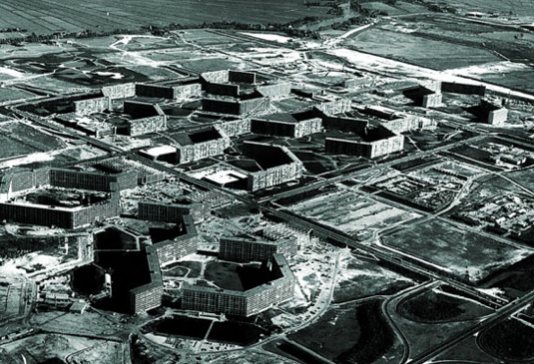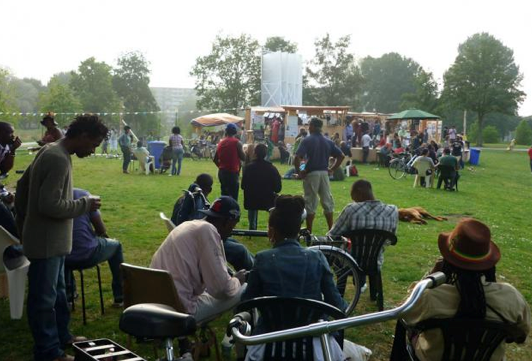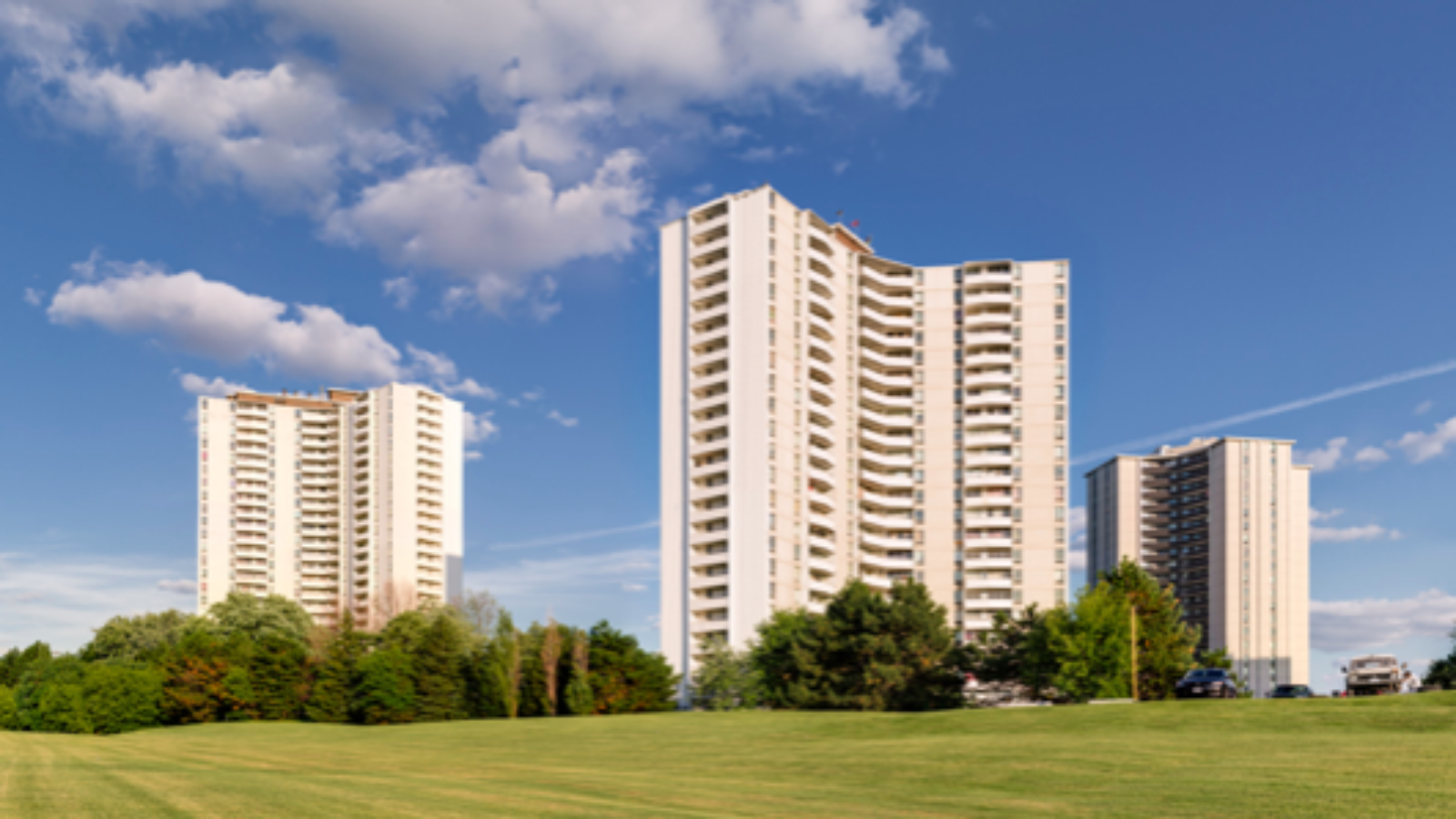By Ross Curtner
Decades ago, English art critic John Berger defined the purpose of art as “to help or encourage men to know and claim their social rights.” All too often, these rights are compromised in the process of urban renewal. The mastermind of modern New York City, Robert Moses, famously illustrated the ‘forget-about-these-people’ attitude that characterized displacements during urban renewal struggles in the 20th century. Currently, a new breed of renewal projects are being discussed in Toronto, Canada. With lessons from the past, a healthier approach is being developed.
Tower Renewal is a priority for the city of Toronto to revamp the 1,200-some mid-century modern apartments that now dot the city’s inner suburbs. Exemplifying Le Corbusier’s ‘Towers in the Park’ typology, the buildings were born out of the Modernist ideals developed during the post-WWII reconstruction era in Europe. In contrast with American suburban development, Toronto saw the construction of residential towers outpacing the growth of single-family dwellings by more than two to one.
However, since construction, the young couples that the building were originally marketed to have moved on and community needs have changed. Many of the towers are now crumbling and the future of the high-rises and the diverse communities they now house demand action.
In the U.S., the ‘action’ for many of the tower blocks took the form of demolition. But in Toronto, architects, city planners, community groups, and others are seeing opportunities in preserving the towers. In fact, studies have shown that renewal has financial, environmental, and social advantages over demolition. Especially, renewal doesn’t require disruptive relocations of previous residents that erase the social networks of inhabitants and perpetuate a trend of displacement for marginalized groups. In addition, redeveloping the towers in line with a number of policy agendas, from energy-efficient retrofitting of buildings and green house gas emissions to poverty reduction and transportation planning.
Precedents and Artistic Provocations
In Europe, tower renewal efforts have made visible progress, setting precedents for Toronto to learn from. One of the most famous examples is the Bijlmer Neighborhood in Amsterdam — a massive project built in the 1960s, derelict by the 1980s but now heralded a success since its master plan completion in 2002.

The Bijlmer circa, 1968
From the perspective of policymaking and urban planning, Swiss artist Thomas Hirschhorn would be an unlikely contributor to Bijlmer. He is known for eclectic installations made of common materials such as duct tape, foil, plywood, and cardboard. Over the last decade, Hirschhorn has created ‘temporary monuments’ dedicated to notable philosophers. Set in neighborhoods where housing renewal projects may take place, Hirschhorn cooperates with residents in designing and constructing large-scale artistic installations, which include features for community use, such as Internet cafes, theaters, and libraries.
The first such monument, dedicated to the renowned 17th century early Enlightenment thinker Baruch Spinoza, was created in Bijlmer in 1999. Named after the philosopher the monument was dedicated to, the entire process of construction and exhibition was called the “Bijlmer Spinoza-Festival.”
E-flux, a popular art journal, noted in 2012, “‘The Bijlmer Spinoza-Festival’ demonstrated an embrace by the local inhabitants of a ‘simple’ social proposition in which a festival-like structure connects with intellectualism in a very simple manner.”
The response from residents who collaborated with Hirschhorn was equally, if not more, enthusiastic. Most wanted the artwork to stay, especially the children who had spent the three months of the installation creating plays and exploring other artistic mediums. Some commented on what they learned through the project, citing the ethics of the philosopher alongside their own worldview. Mr. Iwan, a member of the 1999 construction team explained, “Mr. Spinoza’s idea was a free human, he just wanted to be free.”

The Bijlmer Spinoza-Festival
Although urban renewal developments can end up marginalizing existing communities, the success of the Bijlmer Spinoza-Festival shows how such cultural projects can fulfill John Berger’s definition of art: encouraging residents to know and claim their social rights.
Cultural Examples in Toronto
In Toronto, some promising examples of cultural work alongside urban renewal have taken the form of film (For examples of other kinds of cultural work, see The Phoenix and Four Seasons). Directed by Katerina Cizek, HIGHRISE is a collaborative documentary project with the National Film Board of Canada, which explores the human experience in ‘vertical suburbs.’ The objective of the project is to “see how the documentary process can drive and participate in social innovation rather than just documenting it, and to help reinvent what it means to be an urban species in the 21st century.”
One of the early HIGHRISE films was called The Thousandth Tower. Through their own points of view, six Toronto tower residents documented and shared their lives in the context of the city’s renewal effort. In many ways, it was the process and the outcome this film that elevated and humanized the city’s Tower Renewal project. Participants presented their work at numerous events, communicating with audiences ranging from architects to university deans and from city administrators to the mayor, creatively amplifying the voices of tower residents that often go unheard during urban renewals.
Cultural Retrofits
In addition to adding new energy-generating photovoltaic facades, transit hubs, and beautified community spaces, tower renewal is at its heart a retrofitting of conventional policy and planning paradigms to reflect the new needs of the communities today. To perform such a renewal requires insights from the community and understandings of cultural contexts of the re-development, as well as the perspectives of planners, energy innovators, and building managers.
Previously featured in the World Policy Journal’s Arts-Policy Nexus, the Artist Round Table (A.RT) is being developed as a frame in which artistic and non-artistic knowledges and practices can engage with each other.

Artist Roundtable, May 2015
In May 2015, curators Scott Baker and Ross Curtner from Adjacent Possibilities, an agency experimenting at the intersection of art and complex social challenges, hosted an A.RT event in Vancouver, Canada, on the theme of ‘New Economies.’ They are now developing another opportunity for art and society to engage with each other on the theme of tower renewal. This next iteration will explore the potential of artistic practice to drive participation from multiple actors in society and enrich the dialogue in the policy terrain of Tower Renewal.
If past development failures resulted from the disconnection between policy agendas and reality, future renewal attempts may benefit from A.RTs and other efforts to involve a rich diversity of cultural perspectives on urban renewal projects.
Indeed, it was Jacob Riis’ photographs of late 19th century New York City apartments that first sparked the conversation on the deplorable living conditions of tower residents and pushed their poverty into the public consciousness. Beyond showcasing the negatives of past and current vertical dwellings, empowering cultural projects and thereby the voices they represent will help both planners and artists articulate new visions for the future of our cities.
*****
*****
Ross Curtner is a co-founder and co-director of Adjacent Possibilities.
[Photo courtesy of ERA Architects, e-flux, THOMAS HIRSCHHORN, and Daniel Rotman]
